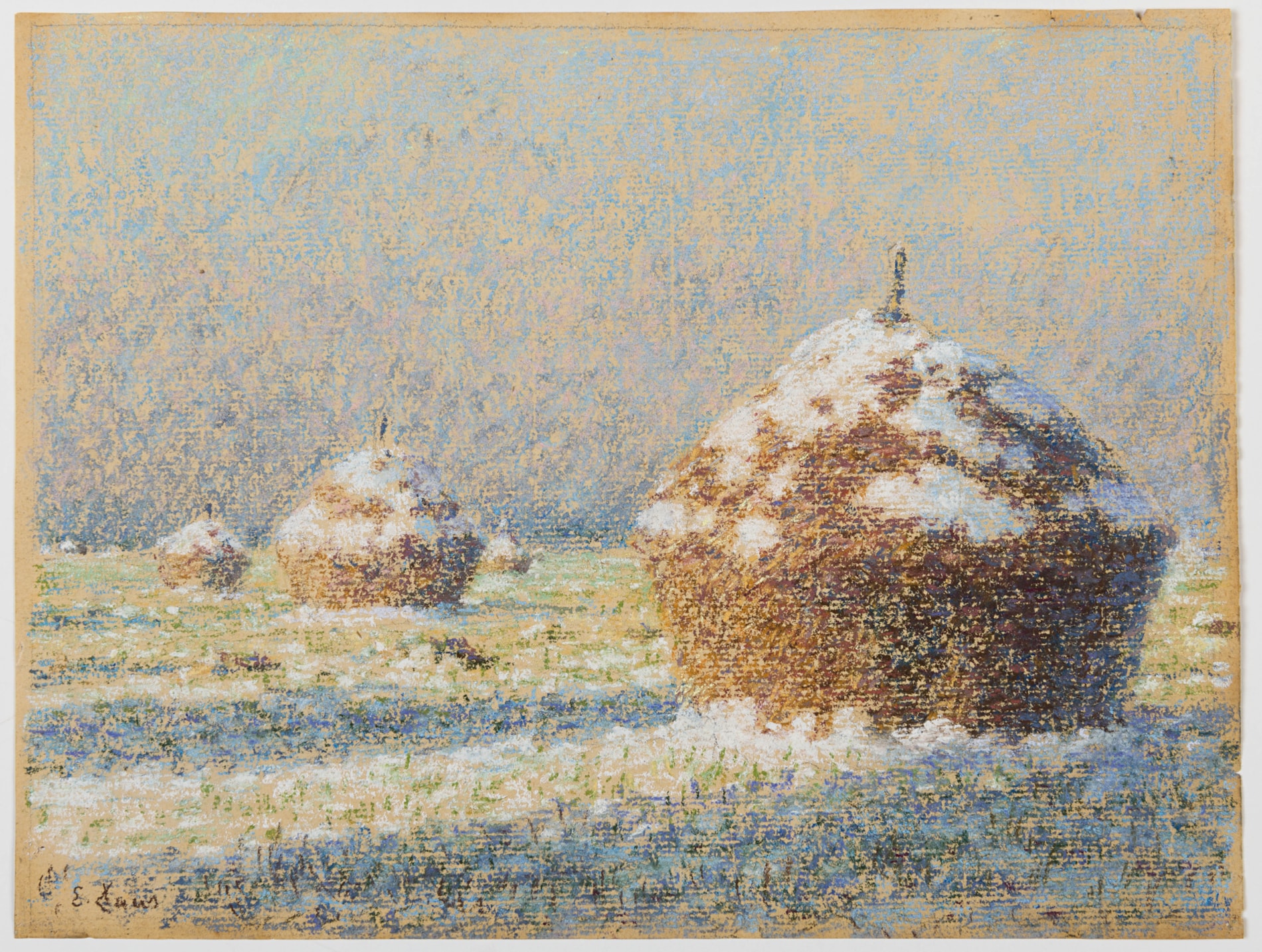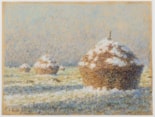Emile CLAUS
(Vive-Saint-Eloi 1849 - Astene 1924)
Grainstacks in the Snow
Sold
Pastel on buff paper.
Signed E. Claus at the lower left.
181 x 239 mm. (7 1/8 x 9 3/8 in.) [sheet]
Signed E. Claus at the lower left.
181 x 239 mm. (7 1/8 x 9 3/8 in.) [sheet]
This exquisite small pastel landscape may be approximately dated to the early 1890s, and reveals the influence on Emile Claus of the work of Claude Monet, whom he met in Paris at around this time. (Monet’s own well-known series of twenty-five paintings of similar stacks of wheat were painted between the summer of 1890 and the spring of 1891. Fifteen of these canvases were exhibited at the Galerie Durand-Ruel in Paris in May 1891, and Claus may well have visited the exhibition, which earned considerable critical acclaim and was a huge commercial success.) Grainstacks (haystacks or stacks of wheat) appear in a number of Claus’s paintings of this period, such as The Gleaners of 1894 in the Museum voor Schone Kunsten in Ghent and Landscape with Grainstacks in a private collection.
Born the twelfth of thirteen children into a family of modest means, the landscape painter Emile Claus was raised on the banks of the Lys (Leie) river in Belgium. He entered the Royal Academy of Fine Arts (Koninklijke Academie voor Schone Kunsten) in Antwerp in 1869, at the age of twenty. A gifted colourist, Claus developed a particular fondness for the landscapes of Belgium and, in particular, the woods and meadows along the Lys, which he painted with an eye to capturing light effects. He also painted a number of splendid peasant portraits and genre subjects, particularly in the early part of his career. In 1883 he settled in a cottage (named Zonneschijn, or ‘Sunshine’) in the town of Astene, on the banks of the Lys river, where he lived until his death. Within a few years he enjoyed some commercial success, with one of his paintings acquired by the museum in Antwerp and another by the Belgian royal family. From 1885 onwards Claus worked in a pointillist technique, developing a style that came to be characterized as ‘luminism’; a personal form of Belgian late Impressionism - with a particular emphasis on light effects - whose other significant adherent was Théo van Rysselberghe.
For much of his career, Claus remained devoted to the Leieland region that he recorded so faithfully in his work. Nevertheless, he travelled through Holland, Italy, Spain and Morocco, and also spent some time working in Paris, where he befriended Claude Monet. In the 1880s his paintings were included in exhibitions in Amsterdam, Budapest, Buenos Aires, Edinburgh, Liverpool, London, New Orleans and, in particular, Paris. In 1899 Claus’s work was praised by one writer: ‘Every one of his canvases, especially those of his later years, has been a successful endeavour to reach the highest perfection in rendering the lovely varied hues of the sky, of summer radiance on land and river. And besides this purely technical, material merit, all his pictures excel in subtle accuracy, in perfect truthfulness of most minute execution…He finds the beautiful, not only in the subject, in its perfect dimensions, but in the colouring of things, in the lovely blending of light and shade, which he applies as but few others can.’ By the turn of the century, Claus was established as one of Belgium’s best-known landscape painters.
In 1904 Claus founded an artistic society Vie et Lumière (‘Life and Light’), and four years later the Belgian writer and journalist Camille Lemonnier, a close friend of the artist, published one of the first monographs on his work. As an anonymous English review of the book noted of Claus, ‘His art is so various, embracing as it does every field that is open to the modern realist, and at the same time so alive to the picturesque in man and nature, so well balanced in its means of expression that it is always certain of finding admirers.’ During the First World War Claus fled to England, where he lived on the banks of the Thames in London and painted a number of striking views of the river and its bridges which are indebted to the example of Monet. (He also spent some time working in Wales.) Claus’s London paintings were exhibited in Brussels in 1921, although by then his art had fallen somewhat out of fashion. The artist died three years later in Astene. A large group of works by Emile Claus is today in the collection of the Museum of Deinze and the Leie Region (Mudel), while others are in the museums in Antwerp, Barcelona, Berlin, Brussels, Douai, Ghent, Ixelles, Liège, Paris, Rome, Venice and elsewhere.
For much of his career, Claus remained devoted to the Leieland region that he recorded so faithfully in his work. Nevertheless, he travelled through Holland, Italy, Spain and Morocco, and also spent some time working in Paris, where he befriended Claude Monet. In the 1880s his paintings were included in exhibitions in Amsterdam, Budapest, Buenos Aires, Edinburgh, Liverpool, London, New Orleans and, in particular, Paris. In 1899 Claus’s work was praised by one writer: ‘Every one of his canvases, especially those of his later years, has been a successful endeavour to reach the highest perfection in rendering the lovely varied hues of the sky, of summer radiance on land and river. And besides this purely technical, material merit, all his pictures excel in subtle accuracy, in perfect truthfulness of most minute execution…He finds the beautiful, not only in the subject, in its perfect dimensions, but in the colouring of things, in the lovely blending of light and shade, which he applies as but few others can.’ By the turn of the century, Claus was established as one of Belgium’s best-known landscape painters.
In 1904 Claus founded an artistic society Vie et Lumière (‘Life and Light’), and four years later the Belgian writer and journalist Camille Lemonnier, a close friend of the artist, published one of the first monographs on his work. As an anonymous English review of the book noted of Claus, ‘His art is so various, embracing as it does every field that is open to the modern realist, and at the same time so alive to the picturesque in man and nature, so well balanced in its means of expression that it is always certain of finding admirers.’ During the First World War Claus fled to England, where he lived on the banks of the Thames in London and painted a number of striking views of the river and its bridges which are indebted to the example of Monet. (He also spent some time working in Wales.) Claus’s London paintings were exhibited in Brussels in 1921, although by then his art had fallen somewhat out of fashion. The artist died three years later in Astene. A large group of works by Emile Claus is today in the collection of the Museum of Deinze and the Leie Region (Mudel), while others are in the museums in Antwerp, Barcelona, Berlin, Brussels, Douai, Ghent, Ixelles, Liège, Paris, Rome, Venice and elsewhere.




